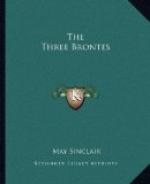Until the publication of the unknown poems, it was possible to ignore the “Gondal Chronicles”. They are not included in Mr. Clement Shorter’s exhaustive list of early and unpublished manuscripts. Nobody knew anything about them except that they were part of a mysterious game of make-believe which Emily and the ever-innocent Anne played together, long after the age when most of us have given up make-believing. There are several references to the Chronicles in the diaries of Emily and Anne. Emily writes in 1841: “The Gondaland are at present in a threatening state, but there is no open rupture as yet. All the princes and princesses of the Royalty are at the Palace of Instruction.” Anne wonders “whether the Gondaland will still be flourishing” in 1845. In 1845 Emily and Anne go for their first long journey together. “And during our excursion we were Ronald Macalgin, Henry Angora, Juliet Angusteena, Rosabella Esmaldan, Ella and Julian Egremont, Catharine Navarre, and Cordelia Fitzaphnold, escaping from the palaces of instruction to join the Royalists, who are hard pressed at present by the victorious Republicans. “The Gondals,” Emily says, “still flourish bright as ever.” Anne is not so sure. “We have not yet finished our ‘Gondal Chronicles’ that we began three years and a half ago. When will they be done? The Gondals are at present in a sad state. The Republicans are uppermost, but the Royalists are not quite overcome. The young sovereigns, with their brothers and sisters, are still at the Palace of Instruction. The Unique Society, about half a year ago, were wrecked on a desert island as they were returning from Gaul. They are still there, but we have not played at them much yet.”
But there are no recognizable references to the Gondal poems. It is not certain whether Charlotte Bronte knew of their existence, not absolutely certain that Anne, who collaborated on the Gondals, knew.
“Bronte specialists” are agreed in dismissing the Chronicles as puerile. But the poems cannot be so dismissed. Written in lyric or ballad form, fluent at their worst and loose, but never feeble; powerful, vehement, and overflowing at their best, their cycle contains some of Emily Bronte’s very finest verse. They are obscure, incoherent sometimes, because they are fragmentary; even poems apparently complete in themselves are fragments, scenes torn out of the vast and complicated epic drama. We have no clue to the history of the Gondals, whereby we can arrange these scenes in their right order. But dark and broken as they are, they yet trail an epic splendour, they bear the whole phantasmagoria of ancestral and of racial memories, of “old, unhappy, far-off things, and battles long ago”. These songs and ballads, strung on no discernible thread, are the voice of an enchanted spirit, recalling the long roll of its secular existences; in whom nothing lives but that mysterious, resurgent memory.
The forms that move through these battles are obscure. You can pick out many of the Gondal poems by the recurring names of heroes and of lands. But where there are no names of heroes and of lands to guide you it is not easy to say exactly which poems are Gondal poems and which are not. But after careful examination and comparison you can make out at least eighty-three of them that are unmistakable, and ten doubtful.




